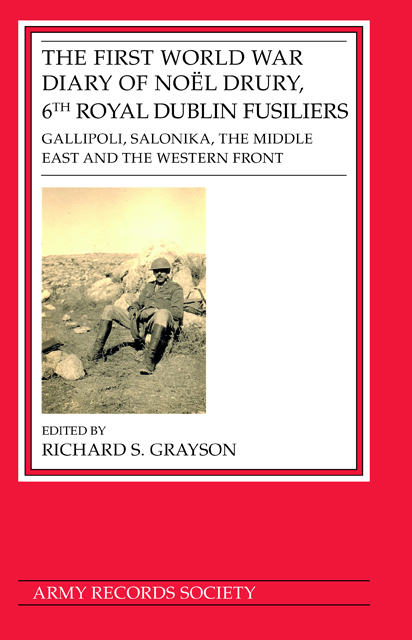 First World War Diary of Noël Drury, 6th Royal Dublin Fusiliers
First World War Diary of Noël Drury, 6th Royal Dublin Fusiliers Book contents
- Frontmatter
- Miscellaneous Frontmatter
- Contents
- List of Illustrations
- Acknowledgements
- List of Abbreviations
- Introduction
- 1 Volunteering and Training, September 1914–July 1915
- 2 The Voyage to the Dardanelles, July–August 1915
- 3 Gallipoli: Landing at Suvla Bay and the Next Ten Days, 7–17 August 1915
- 4 Gallipoli: Digging In, 18 August–October
- 5 The Serbian Front and the Battle of Kosturino, October–December 1915
- 6 The Salonika Front and Hospital, December 1915–September 1917
- 7 Egypt and Palestine, September–December 1917
- 8 Defending Jerusalem and the Battle of Tell ‘Asur, December 1917–July 1918
- 9 France, July–11 November 1918
- 10 Armistice, 12 November 1918– 11 March 1919
- Appendix 1 6th Royal Dublin Fusiliers leaving home for service overseas, 10 July 1915
- Appendix 2 The Effects of the Gallipoli Campaign on the 6th Royal Dublin Fusiliers
- Appendix 3 Officers of the 6th Royal Dublin Fusiliers at Hastière-sur-Meuse, Nov 1918
- Biographies
- Bibliography
- Index
2 - The Voyage to the Dardanelles, July–August 1915
Published online by Cambridge University Press: 14 June 2023
- Frontmatter
- Miscellaneous Frontmatter
- Contents
- List of Illustrations
- Acknowledgements
- List of Abbreviations
- Introduction
- 1 Volunteering and Training, September 1914–July 1915
- 2 The Voyage to the Dardanelles, July–August 1915
- 3 Gallipoli: Landing at Suvla Bay and the Next Ten Days, 7–17 August 1915
- 4 Gallipoli: Digging In, 18 August–October
- 5 The Serbian Front and the Battle of Kosturino, October–December 1915
- 6 The Salonika Front and Hospital, December 1915–September 1917
- 7 Egypt and Palestine, September–December 1917
- 8 Defending Jerusalem and the Battle of Tell ‘Asur, December 1917–July 1918
- 9 France, July–11 November 1918
- 10 Armistice, 12 November 1918– 11 March 1919
- Appendix 1 6th Royal Dublin Fusiliers leaving home for service overseas, 10 July 1915
- Appendix 2 The Effects of the Gallipoli Campaign on the 6th Royal Dublin Fusiliers
- Appendix 3 Officers of the 6th Royal Dublin Fusiliers at Hastière-sur-Meuse, Nov 1918
- Biographies
- Bibliography
- Index
Summary
The 10th (Irish) Division left England not knowing exactly where they were to be deployed. However, the decision had already been taken to deploy them to the Dardanelles because successive phases of the campaign there had failed. Initially, the British and French hoped that a naval bombardment from 19 February 1915 would destroy Turkey's defences along the Dardanelles passage at the entrance of the Sea of Marmara which led to Constantinople. Then, through a mix of land and sea power the Turkish capital would be seized and the Central Powers would lose a key ally. However, no such breakthrough took place and on 25 April 1915 an amphibious operation began at Cape Helles (on the Gallipoli Peninsula's south) and at an area which became known as Anzac Cove (on the west). The troops who landed there were highly trained Regulars but they soon became bogged down. Over May to July 1915 discussions led to a decision to try to break out of Anzac Cove while also deploying two New Army divisions, the 10th (Irish) and the 11th (Northern) to secure a winter harbour at Suvla Bay. These fresh soldiers would work with the Australian, Indian and New Zealand units already there.
The 6th Royal Dublin Fusiliers left Keyham in Plymouth at 3.30pm on Saturday 10 July 1915 on the former Cunard liner the Alaunia. With them were the 7th Royal Dublin Fusiliers, 31st Field Ambulance and parts of the 6th and 7th Royal Munster Fusiliers and the 5th and 6th Royal Inniskilling Fusiliers. Battalion strength was a total of 952: 29 officers, 6 warrant officers, 45 sergeants, 8 lance sergeants, 34 corporals, 42 lance corporals and 797 privates.
The voyage was a leisurely one, despite early rising. Drury worried that ‘we will all get fairly soft by the time we land, as we don't get much exercise and we eat a lot more than in camp’. However, there was some opportunity to exercise on deck and use rudimentary gym equipment. Drury's main responsibility was censoring the letters home which men hoped to post when they put ashore. Within five days, the men had much to write home about as they had seen first the Rock of Gibraltar6 and then had sight of the North African coast, which would have been new to most of them.
- Type
- Chapter
- Information
- First World War Diary of Noël Drury, 6th Royal Dublin FusiliersGallipoli, Salonika, the Middle East and the Western Front, pp. 31 - 45Publisher: Boydell & BrewerPrint publication year: 2022


